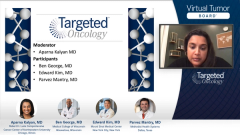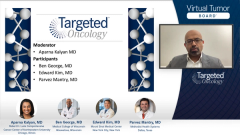
Future Treatment Approaches for HCC
Closing out their discussion on the management of hepatocellular carcinoma, panelists discuss future novel therapies that may impact the treatment landscape.
Episodes in this series

Transcript:
Aparna Kalyan, MD: Dr Kim, do you notice anything with your medical oncologists pattern wise in terms of how they approach these patients?
Edward Kim, MD: Our medical oncologists see them when the patients progress on the systemic therapy. We have inside discussions that for individuals who may have issues coming in, either they live far away and certainly not in New York, but elsewhere, rural areas, maybe an oral agent is easier than coming in for infusions every couple of weeks, 3 to 4 weeks, or whatever the regimen would be. That may be a potential advantage in that type of situation. The majority of our patients now, with the IMbrave150 data, tend to get atezo-bev [atezolizumab plus bevacizumab] first line as long as all those issues aren’t in play for the hypertension, varices, etc. We will combine them with locoregional therapy, usually Y-90 [yttrium-90 radioembolization]. And there are no data to really support this, but we’ve started with the atezolizumab component and held the bevacizumab due to issues with transarterial therapies in bevacizumab, and then once they receive the Y-90 or a chemoembolization, start the bevacizumab component right afterward. But again, this is all in the setting of a multidisciplinary conference.
Aparna Kalyan, MD: You’re right. The future is going to be, how are all these combination therapies going to come into play? As we bring the session to a conclusion, my thought to both of you would be what do you think the future looks like? I personally feel like there’s going to be a struggle in terms of what I do in the second line, particularly if there are combinations that come out, because I don’t know how to look at that space. I’m curious to know, Dr Kim, what do you think from an interventional radiology perspective, and then maybe Dr George, from a medical oncology perspective?
Edward Kim, MD: The future is quite exciting to me because we’re going to start looking at combinations. What has been published to date, a 35%, 40% objective response with the systemic therapies alone, I don’t think we’re satisfied with that. Combining it with some type of other therapy, whether it’s locoregional therapy to incite the immune response, the possibility of getting much higher responses for our patients is very exciting. Also the combination of checkpoint inhibitors, and as discussed previously, the CTLA-4, will hopefully open a whole new bag of tools for oncologists to use. It was quite frustrating in the past when everyone would shout out, “Let’s do Y-90 for this case.” And I’d sit there and say, “I don’t know if this is appropriate for this patient, they have 70% of their liver overtaken with disease.” And then, “We can’t just sit here and not do anything, the sorafenib isn’t going to do much for this individual.” But now it’s different because those patients can truly benefit from checkpoint inhibitors, and if they’re one of the lucky few who are part of that response, we’ve seen incredible and dramatic responses that have altered patients’ lives who were previously told, “Hey, you’ve got 3 to 4 months to live.” I’m seeing them 3, 4 years out now. It’s quite an exciting time for these patients.
Ben George, MD: The future is going to be very confusing, as it should be, in a sense that there’s going to be a plethora of options to choose from. We are already seeing therapeutics in the entire spectrum of the disease. We are already seeing the data from neoadjuvant cabo-nivo [cabozantinib plus nivolumab] that were presented. We will see the readouts from the adjuvant studies. We will see the readout from the EMERALD and the LEAP studies that are combining locoregional treatments with systemic therapies. Then we will have readouts from a bevy of metastatic studies with all kinds of combinations, immunotherapy with TKIs [tyrosine kinase inhibitors], immunotherapy with anti-VEGF agents, and by the time those readouts are out, I hope there will be new exciting agents that will be in the phase 1 and phase 2 setting that will be raising the bar even higher. Overall, as Dr Kalyan and Dr Kim mentioned, there will be a plethora of options, and it will be much better for our patients. Ultimately, how do you sequence it? And that may be something where we will all have to think very carefully through, and identifying subsets. Ultimately that may be what is key, identifying the subsets that respond to specific therapeutics. How do you maximize efficacy, minimize toxicity, and put people in various groups or buckets based on therapeutic options? But we’ll see what the future brings.
Aparna Kalyan, MD: It’s an exciting time from a medical oncology perspective. For so long, it’s been so depressing that it’s nice to have all these options. The one thing I would say is patients ultimately see the benefit from all of this. They are the ones who we’re able to have some of these nice conversations with. I just want to end on a nice note. I had a patient who was having ascites on a frequent basic. He finally got a little better and we put him on a clinical trial, and he was just getting single-agent nivo [nivolumab]. He’s now 3 years out of treatment and I just monitor him. I usually give him a call when I’m having a bad day and I’m like, “I just want to see you in clinic just because I feel better when I see you.” It’s nice when we’re able to do that, and I don’t think we’ve had that very often, and this is a nice space for us to think about moving forward.
I want to take this time now to thank our panel. It’s been such a thoughtful and lively and informative discussion. I’m always surprised at how much I learn from all these discussions, no matter how many times you see the same thing, you learn so much. To our viewing audience, thank you for joining us for this Targeted Oncology™ Virtual Tumor Board® presentation. We hope today’s discussion was a valuable use of your time and that you acquired some practical knowledge that you can take back to your clinic. Thank you.
Transcript edited for clarity.












































